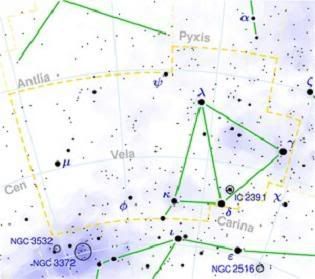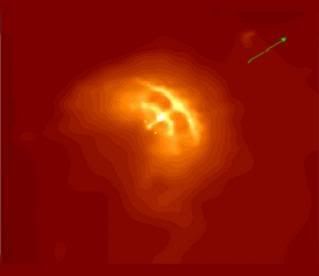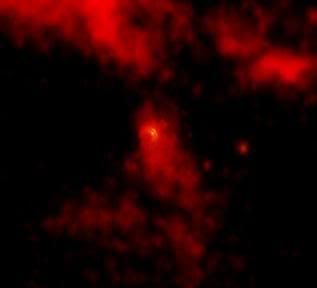Post by glactus on Feb 17, 2008 5:00:38 GMT

Vela is a southern Constellation and formerly part of the very large constellation Argo Narvis - the ship of Jason and the Argonauts who sort the Golden fleece. Vela lies in a part of the Milky Way rich in faint nebulosity known as the Gum Nebula. Near the centre of this gigantic nebula lies the Vela Supernova remnant, which photographs show as a beautiful intricate network of filaments. Within the remnant is the Vela pulsar, lying about 1500 light years away. To find Vela look towards the zenith in the late evening sky, and look a little north of a line between the Southern Cross and Canopus.
Notable stars:
Gamma Velorum
Gamma Velorum at magnitude 1.7 is one of the brightest stars in the nighttime sky. Due to the exotic nature of its dark absorption lines, it is also dubbed the Spectral Gem of the Southern Skies. Distance from Earth is approx. 800 light years.
Delta Velorum
Delta Velorum is a star system approximately 79.7 light years from Earth. The system is composed of two binary stars. The brightest of the four stars, q Velorum A, is a white A-type main sequence dwarf with an apparent magnitude of 2.02. Its binary companion, q Velorum B, has a magnitude of 5.1 and is separated from the A component by 2.6 arcseconds. The second binary system is 69 arcseconds away. It is composed of the 11th magnitude q Velorum C and the 13th magnitude q Velorum D, which are 6 arcseconds apart.
Lambda velorum
Lambda Velorum is a supergiant of spectral class K5. Giant stars like lambda Velorum use up their hydrogen fuel much faster than do smaller stars and Lambda Vel. is estimated to be only some 27 million years old. It is classified as an irregular variable and its brightness varies from magnitude 2.14 to 2.30. Distance from Earth is 570 light years.
Notable objects:

NGC 3132
NGC 3132 (The Southern Ring Nebula) is a planetary nebula situated about 2,000 light years from Earth. Photos of NGC 3132 reveal two stars close together, one of 10th magnitude and one of 16th. It is the fainter one of these that is considered the central star, having blown off its outer layers to form the nebula. This central star has a very hot surface of perhaps 100,000 kelvins and emits intense ultraviolet radiation which light up the gasses in the nebula. The shell of gasses is expanding at about 9 miles per second (24 km/s).

The Vela supernova remnant
The Vela supernova remnant is the remains of a
supernova that exploded approximately 11,000-12,300 years ago. The association of the Vela supernova remnant with the Vela pulsar, made by astronomers at the University of Sydney in 1968 was direct observational proof that supernovae form neutron stars. Distance from Earth is 800 light years and magnitude is 12.1.

Vela pulsar
This image shows a dramatic bow-like structure at the leading edge of the cloud, or nebula, embedded in the Vela supernova remnant. This bow and the smaller one inside it, are thought to be the near edges of tilted rings of X-ray emission from high-energy particles produced by the central neutron star. Perpendicular to the bows are jets that emanate from the central pulsar, or neutron star. As indicated by the green arrow, the jets point in the same direction as the motion of the pulsar. The swept back appearance of the nebula is due to the motion of the pulsar through the supernova remnant. Distance from Earth is 1,500 light years and magnitude is 13.5.

Vela pulsar magnetic field
The Vela pulsar was born 10,000 years ago at the center of a supernova -- an exploding star. In this Chandra Observatory x-ray image, the pulsar still produces a glowing nebula at the heart of the expanding cloud of stellar debris. The pulsar itself is a neutron star, formed as the stellar core was compacted to ignite the nuclear fire. With a strong magnetic field, approximately the mass of the Sun, and a diameter of only 20 kilometers, the Vela pulsar rotates 11 times a second.

credits:
Vela map:Wikipdia
en.wikipedia.org/wiki/Vela_(constellation)
image:NGC 3132: Wikipedia
en.wikipedia.org/wiki/Image:NGC_3132.jpg
image: Vela supernova remnant: special credit: Digitized Sky Survey/ESA/ESO/NASA FITS Liberator.Wikipedia
en.wikipedia.org/wiki/Image:Vela_skyfactory_big.jpg
image: Vela pulsar: chandra.harvard
chandra.harvard.edu/photo/2000/vela/
image: Vella pulsar wind:apod.nasa
apod.nasa.gov/apod/ap010719.html


